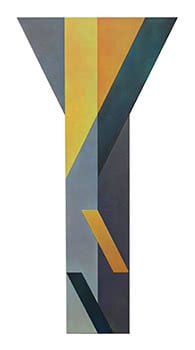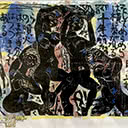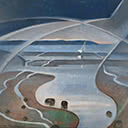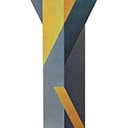Modernism Meets Tane Mahuta No.1
180 x 90 cm
est. $8,500 - 9,500
PROVENANCE Purchased directly from the artist
Modernism Meets Tane Mahuta series of paintings shows Good at his simplest and "blockiest", just five planes forming a column that flares out at the top, and four relatively pure and flat colours - the three primaries plus a dark almost-black. It is a throwback to the 1970s when Good's style was more often based on stark interlocking geometries and contrasting colours (as opposed, say, to the interweaving, optically complex configurations of the late 1980s-early 2000s or the earthy palette that emerged in the early 1980s and only really brightened again around 2007, when Good began more earnestly to revisit his 1970s pictorial ideas). The way shapes are stacked vertically brings to mind works such as Colour Column (1973) and Untitled - Column (1974), as well as the Lintel and Column paintings of 1974 and 2009.
Perhaps the most striking comparison is with the large vertical rectangle, Doric (1972), with its glaringly bold primaries and angles that similarly stretch the central column structure. Doric, in title and form, signals an interest in parallels between painting and architecture, as well as finding a lineage for modernist abstraction in the elemental forms of ancient Greece. The tower, both fundamental and aspirational, often grandiosely utopian, is the ultimate modernist statement, from the Eiffel Tower completed in 1889, to Vladimir Tatlin's unrealised, Constructivist Monument to the Third International (1923), to Brancusi's Endless Column (1918), Barnett Newman's Broken Obelisk (1963-69), and the contrasting towers that came out of the Bauhaus's drive for efficiency - austere concrete apartment blocks that often ended up being conspicuous reminders in Europe of social inequality, and the glittering glass- wall "corporate modernism" of Philip Johnson and others who designed skyscrapers commensurate with the wealth and power of multinational corporations - monuments to capitalism, in contrast to Tatlin's monument to Soviet communism. So Modernism Meets Tane Mahuta is itself a monument - to the history of modernism that Good has surveyed and effectively represented (a painting of modernism). ended up being conspicuous reminders in Europe of social inequality, and the glittering glass-wall "corporate modernism" of Philip Johnson and others who designed skyscrapers commensurate with the wealth and power of multinational corporations - monuments to capitalism, in contrast to Tatlin's monument to Soviet communism.
Edward Hanfling Parallel Universe - the Art & Design of Roy Good Te Uru Publication 2018





